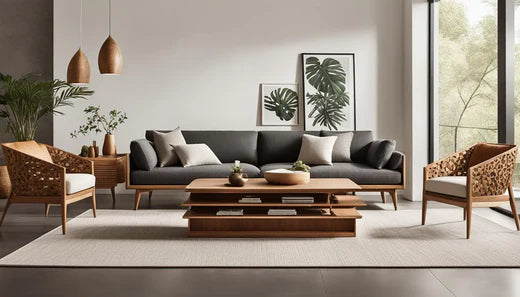
The Future of Furniture Market: Innovations Shaping the Next Era of Living Spaces
Share

Introduction
The furniture industry is undergoing a rapid transformation. As interior design continues to evolve, cutting-edge technologies and groundbreaking design concepts are reshaping the way we experience and interact with our living spaces. This revolution in furniture design is not only improving functionality but is also redefining the way we approach comfort, sustainability, and space utilization. For investors, the dynamic growth of the furniture sector presents a unique opportunity to tap into a market brimming with potential.
1. Multifunctional Furniture Design: Maximizing Space in a Crowded World
As urbanization accelerates and property prices continue to rise, maximizing living space has become a priority for homeowners and renters alike. Multifunctional furniture is the response to this growing need for space-efficient, durable solutions. This furniture integrates advanced technologies, allowing it to serve multiple purposes—whether it’s a sofa that transforms into a bed, or a dining table that doubles as a work desk. These designs are not only practical but also visually appealing, offering customers the ability to save space without sacrificing style.
For investors, the demand for multifunctional furniture represents a significant growth opportunity. With more people moving into smaller spaces, there is a rising need for furniture that offers flexibility and convenience. Multifunctional designs are becoming a key selling point, and companies that innovate in this area are poised to capture a larger share of the market.
2. Smart Furniture: Integrating the Internet of Things (IoT) for a Seamless Experience
In today’s tech-savvy world, furniture makers are embracing the Internet of Things (IoT) to create “smart” furniture that enhances both functionality and design. By incorporating sensor technology and real-time user data, smart furniture enables a personalized experience. Imagine a desk that adjusts to your posture or a chair that tracks your seating habits to improve comfort. These pieces are designed to improve the user experience in ways traditional furniture cannot.
The integration of IoT into furniture design is a game-changer. It not only brings increased functionality but also offers new ways to engage customers. As more consumers demand smarter, more connected living spaces, the smart furniture market is expected to grow exponentially. For investors, this opens up opportunities in the intersection of furniture, technology, and consumer electronics.
3. Additive Manufacturing: 3D Printing Revolutionizes Furniture Production
Additive manufacturing, or 3D printing, is transforming traditional furniture production methods. By enabling designers to create highly customized and intricate furniture pieces, 3D printing removes many of the limitations imposed by traditional manufacturing processes. This technology simplifies the creation of complex shapes, reduces material waste, and offers unparalleled design flexibility.
One of the most significant advantages of additive manufacturing is its ability to create bespoke furniture at scale. Consumers can personalize their pieces, whether it's a chair with specific dimensions or a table with a custom design. The cost-efficiency and design possibilities offered by 3D printing present exciting opportunities for companies to offer unique, made-to-order furniture at competitive prices. Investors can look to capitalize on this trend, as additive manufacturing will likely play a central role in the future of furniture production.
4. Immersive Technologies: Revolutionizing the Furniture Buying Experience
Immersive technologies such as augmented reality (AR), virtual reality (VR), and extended reality (XR) are changing the way consumers interact with furniture before making a purchase. These technologies allow customers to visualize and virtually “try” furniture in their homes, offering realistic simulations of how pieces will look and fit within a space. By leveraging AR and VR, furniture companies provide customers with the ability to see photorealistic renderings of products from the comfort of their homes.
This shift in the buying experience not only enhances customer satisfaction but also reduces the likelihood of returns, creating a more efficient and streamlined process. For investors, companies adopting immersive technologies offer significant growth potential, as this trend is rapidly gaining traction in the retail space. The furniture industry’s embrace of immersive tech presents a compelling investment opportunity in the future of consumer shopping experiences.
5. Sustainable Furniture: A Commitment to Eco-Friendly Practices
As sustainability becomes increasingly important to consumers, the furniture industry is undergoing a notable shift towards eco-friendly materials and practices. From sustainable wood sources to biodegradable fabrics, furniture manufacturers are embracing greener alternatives in response to the growing demand for environmentally conscious products. This shift not only reduces the carbon footprint of furniture production but also appeals to an eco-conscious market that prioritizes ethical consumerism.
Investors should take note of the furniture brands that are leading the charge in sustainability. The demand for environmentally friendly furniture is expected to rise, especially as consumers continue to seek products that align with their values. Brands that adopt sustainable practices and source eco-friendly materials are poised to see significant market growth, making this a promising sector for long-term investment.
Conclusion: The Future of Living Spaces
The furniture industry is on the brink of a major transformation, driven by a confluence of technological advancements, innovative design concepts, and an increasing emphasis on sustainability. From multifunctional furniture and smart technologies to 3D printing and immersive buying experiences, these innovations are redefining how consumers furnish and interact with their living spaces.
As the market for modern furniture continues to expand, investors have a unique opportunity to capitalize on the intersection of design, technology, and sustainability. The shift towards smarter, more sustainable, and customizable furniture solutions is not only revolutionizing the industry but also enhancing the quality of life for consumers.
For those looking to invest in the future of interior design, the furniture industry offers a dynamic and promising landscape. With new innovations emerging every day, the journey to redefine living spaces is only just beginning, and the potential for growth is limitless.